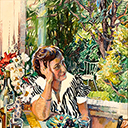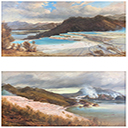Lively Conversation at Luncheon - Edith Campion
75 x 59.5 cm
est. $40,000 - $60,000
PROVENANCE
Commissioned by the artist's friends
Edith and Richard Campion
Private Collection, Australia
ILLUSTRATED
p. 51, plate 27, Evelyn Page, Seven
Decades, Neil Roberts,
Robert McDougall Art Gallery, 1986
EXHIBITED
Evelyn Page, Seven Decades, National
touring exhibition, cat. no. 67, December 1986 - June 1988
Edith Campion nee Hannah was born in Wellington December 13, 1923. She married theatre director Richard Campion in 1945 and together, in 1952, they formed the New Zealand Players, laying the foundations of professional theatre in New Zealand. She was schooled at Queen Margaret's and Nga Tawa, before being privately educated from age 13, later attending Wellington's Victoria University then enrolling in an acting course at the Old Vic Theatre School in London in 1948. She was a member of the Downstage Theatre Trust board. Campion's publications included A Place to Pass Through and Other Stories in 1977 and a 1979 novel collaboration with Frank Sargeson, The Chain & En Route. She had many stories and poems published in Islands, Landfall and NZ Listener, as well as readings of her work on Radio New Zealand. Edith was mother to well known director and screenwriter Anna and Jane Campion.
Born in 1899, Evelyn Margaret Polson was the youngest of seven children. Her parents John and Elizabeth Polson were straight-laced, "Victorian" as Evelyn described them. Although this was a strictly religious upbringing, she was encouraged to foster a love of music, art and writing from a young age. In 1915, 15-year-old Evelyn joined the Canterbury College School of Arts where her formal training began and she would remain until 1922. She quickly proved herself to be a talented student, receiving numerous accolades and prizes. This was of course a formative time for the young artist, who in addition to learning from teachers Margaret Stoddart, Leonard Booth and Cecil Kelly, forged a number of lifelong friendships and connections with her peers including Ngaio Marsh and Viola Macmillan Brown. She became a member of the Canterbury Society of Arts in 1922. For a period after this, Page focused on music, studying piano with Ernest Empson. Awareness of this musical talent deepens an appreciation her paintings, which have a musical sensitivity to them. Page's affinity for finding rhythm in composition and colour gives many of her works a deep visual musicality. It was through Empson that she met Frederick Page. In 1931, one of the few works Evelyn completed was a very fine oil portrait of her future husband. Evelyn was one of the founding members of the New Zealand Society of Artists and taught part-time at Christchurch Girls' School before joining Frederick in London in 1937. The period that followed was one of exceptional and prolific creative output for her. Over this time, the couple built their network of friends and fellow artists in London, and travelled around Europe. Upon their return to New Zealand, Frederick and Evelyn married and settled in Governors Bay, where they lived for several years. They had two children, Sebastian and Anna. Whilst living there, and over the course of a number of summer painting holidays (a tradition she maintained throughout her life), Evelyn mastered the pure treatment of colour in her work. After Frederick was appointed to set up the School of Music at Victoria University in 1945, the family moved to Wellington. Evelyn and the children lived in Pukerua Bay; she used to travel into the city to visit Frederick and to paint. Her wonderfully expressive portraits of friends and peers, interior still lifes and cityscapes now stand out as a form of protest in response to mainstream modernism. The Pages returned to London and Evelyn attended a summer school in Salzburg. In the 1960s and 1970s, Page's work assumed a quieter, more interior focus. Living in Waikanae and suffering from arthritis, a slower rhythm sustained her in the final decades of her work. She died in 1988. Page was a visionary, and her works possess a refreshing vivacity of spirit which have stood the test of time.
For more information on this piece, please download this PDF (76KB)





